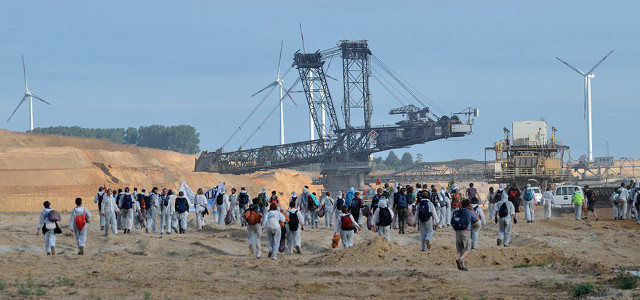Over the weekend, protesters entered coalfields outside of Cologne as a part of the Ende Gelände campaign (loosely translated: “terminal terrain”). The goal is to “keep coal in the ground.” Craig Morris wonders if the event, which unfortunately became violent, is the beginning of a successful divestment movement.

Stop digging, keep it in the ground! (Photo by Tim Wagner, 350.org, CC BY-NC-SA 2.0)
Garzweiler is a giant lignite field. The excavating machines are among the largest moving vehicles ever built. On Google maps, Garzweiler seems as large as the city of Cologne some 30 kilometers east – next to numerous other smaller lignite fields.
On Saturday, demonstrators entered the terrain and climbed onto the excavators, successfully stopping lignite production for hours. The people did so at considerable risk; as the police pointed out, merely approaching the field’s edge is dangerous because the slopes are not secure. And as RWE – the utility that owns the fields – pointed out, the area is also private property, so the demonstrators were trespassing.
The demonstration had been planned for months; such international climate personalities as Naomi Klein and Bill McKibben were also present. The police showed up with some 1,100 officers (report in German). The protesters created a Climate Camp nearby, where a 10-day summer school session on degrowth was held, and it was registered with the police, but the intent to enter the coal fields was not.
German journalist Malte Kreuzfeldt tweeted live from the event. He tried to convince RWE representatives that he was a member of the press, not a demonstrator, and thus had a right to be present because of public interest. Nonetheless, he was also forcibly removed. Via Twitter, he documented the use of tear gas and force against the protesters, which sometimes got bloody. Tempers must have been high on both sides; protesters came out in special full-body suits, and police wore riot gear – in the sweltering heat of a pit.
The official police report speaks of two groups of hundreds that made it into the coalfields illegally (in German). Out of a total of 1,200 demonstrators, 805 people trespassed; 36 people were reportedly injured, 15 of them police officers. (The activists charge that at least some of the officers were injured by their own use of pepper spray). In addition to trespassing, some protesters will be charged with illegal arms possession and disturbing the peace.
Kreuzfeldt writes that the protest met with a mixed response among locals (in German). 7,600 people have already been relocated from Garzweiler, which has gobbled up 12 villages. Five others are already scheduled to go, affecting some 1,600 inhabitants. Another demonstration in one of these villages brought together an additional 800 people. But some locals are happy to move, especially the young ones who can start new lives elsewhere with the payoff from RWE, Kreuzfeldt reports. (See my previous article on why some locals are happy to take the money and run). And of course, local jobs in the coal sector are on the line.
The event met with a mixed response in the press as well. A commentator on German national television called RWE’s reaction “ridiculous,” while a local paper said the activists “went too far.”
Protests against coal excavation have gone on in Germany for decades, but they have not had as much success as the nuclear phaseout for two main reasons. First, the coal sector grew gradually over decades, whereas nuclear appeared more abruptly in the 1970s. Second, the nuclear sector consists of four firms, whereas numerous utilities (and industrial firms) have coal assets.
But underground hard coal mining will soon come to an end in Germany. In 2018, subsidies for domestic hard coal mining will finally end; Germany will still import hard coal, but its domestic production is not competitive internationally. The country will then only have domestic lignite production – and those fields are, a bit like nuclear, in the hands of just a few firms.
There is no doubt that the protest was illegal. But so were many of the nuclear protests. The first one in Wyhl (1974) immediately brought together some 25,000 people, and as many as 80,000 came together later in Brokdorf, where protests resembled a Civil War at times. Likewise, in 2010 120,000 people joined hands between the Brunsbüttel and Krümmel nuclear plants in a peaceful protest against Chancellor Merkel’s plans to extend nuclear reactor commissions.
Ende Gelände does not have that momentum yet. On Facebook, American-born German coal expert Jeffrey Michel summed up the mainstream criticism of the protesters well (in German): “The people in Heuersdorf, Saxony, (where I lived until I was relocated) protested from 1992 to 2008… without ever committing a single crime or being sprayed with pepper.” Yes, Jeff, and Heuersdorf lost. It no longer exists. The protesters are looking for ways to win. I wasn’t at the demonstration myself, but eyewitness reports do not suggest that the protesters provoked police violence.
The question is therefore whether there are tens of thousands of Germans willing to put their bodies on the line in an effort to keep carbon in the ground. From activists to police officers to the general public, we can probably all agree on one thing: A peaceful protest with tens of thousands would have a greater impact than a violent one with hundreds.
Craig Morris (@PPchef) is the lead author of German Energy Transition. He directs Petite Planète and writes every workday for Renewables International.